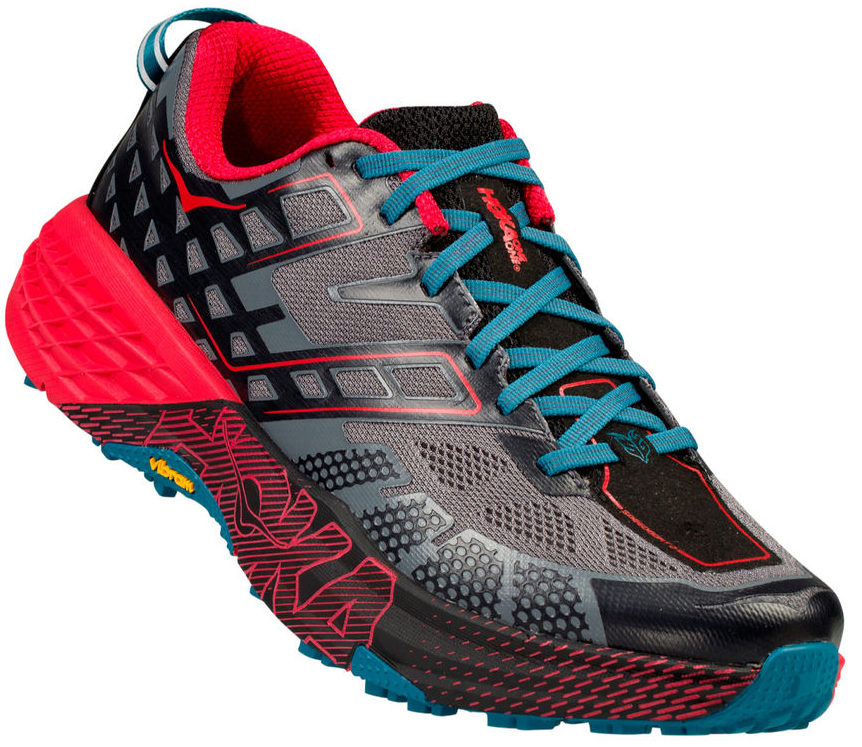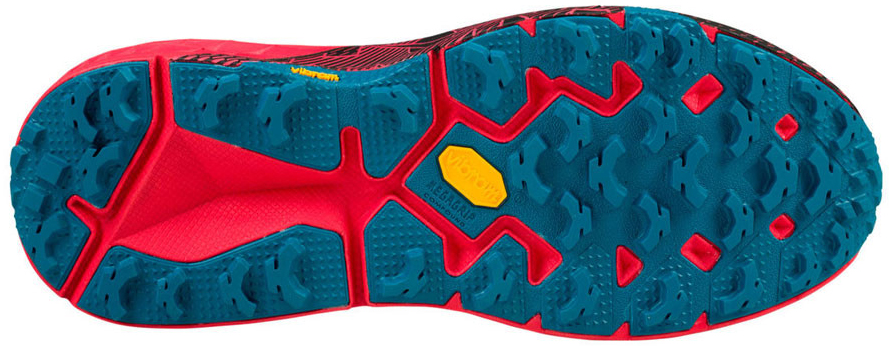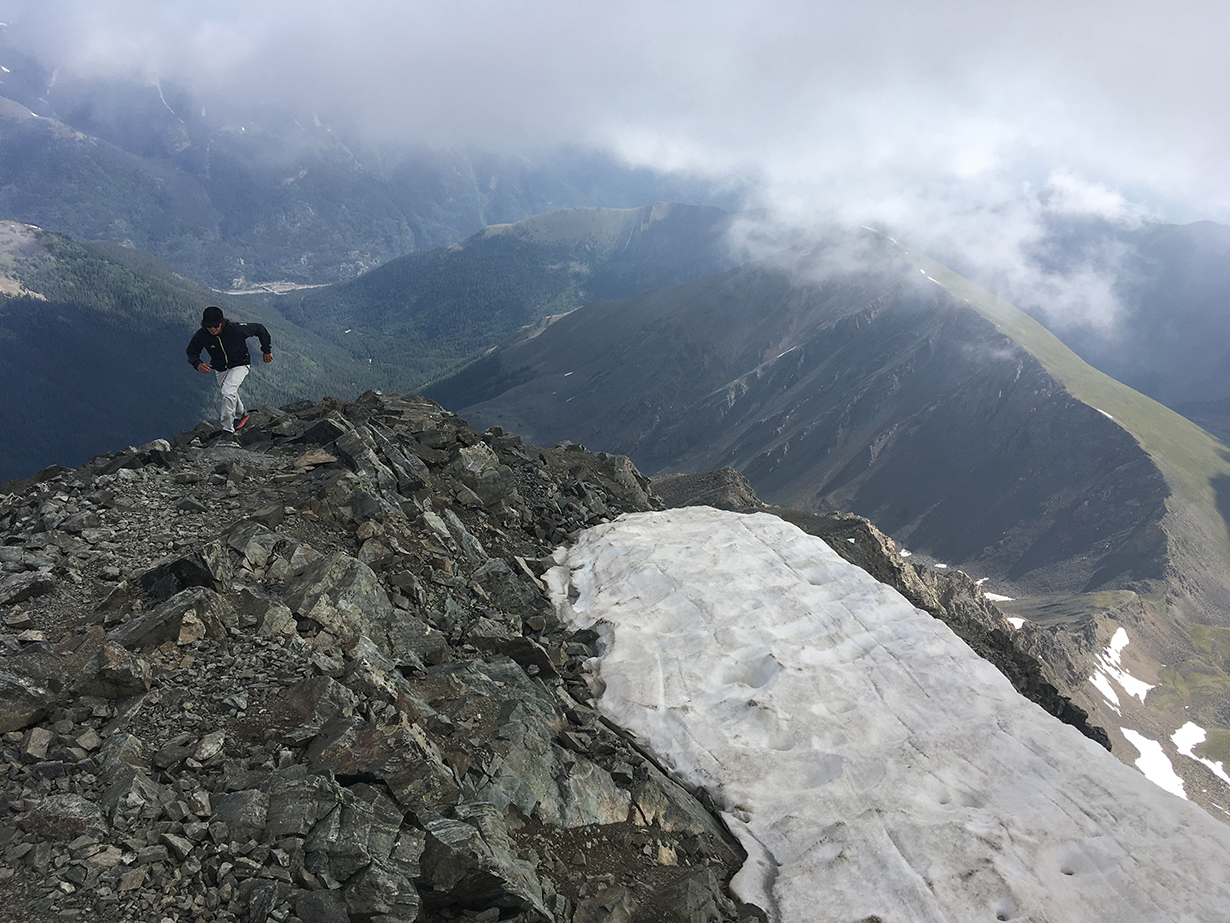
Hoka One One Speedgoat 2
Drop: 4.5 mm
Some Stated Features
- Forgiving, comfortable uppers with engineered mesh offer breathability and support
- Reinforced SpeedFrame construction
- Midfoot cages provide stability
- Oversize CMEVA/EVA midsoles
- Wide midsoles
- Vibram® Megagrip high-traction outsoles with aggressive, multidirectional 5mm lugs
MSRP: $140
Size Tested: 10
Blister’s Measured Weight per Shoe:
- Shoes + Laces: 272 g
- Insoles: 25 g
- Total: 297 g
Test Locations: Fort Collins, Grays & Torreys Peaks, Guanella Pass, & Crested Butte, CO; Milwaukee & Eagle River, WI.
Test Duration: ~300 miles
Reviewer: 5’8”, 155 lbs.
More on My Running Background, Style, and General Preferences
Intro
Hoka One One, a brand best-known for its highly-cushioned road and trail shoes, recently revamped their most technical trail shoe, the Speedgoat.
The Speedgoat 2 is a pretty significant departure from the original version, and both shoes were developed with Karl Meltzer — the current speed record holder for the 2,190 miles Appalachian Trail (he completed it in under 46 days).
According to Hoka, the new Speedgoat 2 features a wider fit, deeper Vibram lugs, and “a more forgiving upper.” I’ve now got my first 120+ miles in the Speedgoat 2, so I can offer my initial impressions and comparisons for the shoe that Hoka says “is designed to attack all breeds of technical trail.”
Fit
As always, it’s a good idea to try on a pair of shoes before committing to them, but I can offer a few fit notes for the Speedgoat 2 (which I tested in my normal running shoe size of 10). Although Hoka emphasizes the wider fit of the Speedgoat 2, it’s definitely not a particularly wide shoe, and it fits narrower than the Hoka Clifton (which has been my road shoe for a couple years).

Compared to the Salomon Sense Mantra, the Speedgoat 2 felt slightly narrower, but it’s pretty close. The Speedgoat 2 is similar to the Altra Timp in the heel and ankle, but the Timp’s “Footshape Toebox” is much wider than the toebox on the Speedgoat 2, which is pretty tapered and basically the opposite shape of the Timp. I had issues with my wide forefoot in the Speedgoat 2 at first, but was able to fine-tune the laces to eventually run without any pain while still getting solid ankle and heel hold, and I never had any issues with blisters.
Construction, Features, Drop, Etc.
The Speedgoat 2’s features are fairly minimal compared to some of the other new trail shoes on the market — there are no carbon fiber plates or fancy laces here. The shoe has a narrow rubber toe bumper that does well with head-on collisions with rocks, but it doesn’t offer much in the case of impacts from the side.
The mesh upper has some thin laminated sections that serve to resist abrasion and provide support, and they have held up well so far.

The Vibram sole has 5 mm lugs that are pretty spaced-out — the negative space is at least the same as the positive (more on traction later). Although it doesn’t have any sort of sock-like liner like the Sense Mantra, the Speedgoat 2’s flat laces do a good job of providing even pressure, locking my heel in, and offering a bit of customization.
An important feature of the Speedgoat 2 (and most Hoka shoes) is the size and cushioning of the midsole. The men’s Speedgoat 2’s midsole is 32 mm at the heel and 27.5 mm at the forefoot, creating a drop of 4.5 mm. The Speedgoat 2’s midsole is similar to the Clifton’s, though a bit firmer and stiffer laterally and longitudinally. The Speedgoat 2 still offers plenty of cushioning, but is not quite as plush as the road-oriented Clifton, which is a trade off for on-trail capabilities. Compared to the Altra Timp, the Speedgoat 2’s midsole is softer / more plush, but is a bit stiffer longitudinally.
Weight (and Comparisons)
The size 10 Speedgoat 2 that I’ve been testing came in at 297 g (~10.5 oz) per shoe with insoles. This is lighter than the Timp (337 g / 11.9 oz) and slightly heavier than the Sense Mantra and Clifton, which have stated weights of 269 g / 9.5 oz and 235 g / 8.3 oz, respectively.

However, when taking into account the fact that the Speedgoat 2 has a full rubber sole and a 27.5 mm midsole at the forefoot, I was very happy with the weight, and I never felt burdened by the shoe’s heft, even on longer runs.
Breathability
I don’t pay much attention to the breathability of most running shoes since my feet sweat a lot no matter what, and as long as I don’t notice my toes sloshing around in a pool of sweat or develop any blisters, I’m alright with the ventilation of most shoes. The Speedgoat 2 vents well enough to the point where I didn’t notice any serious lack of breathability, and it definitely breathes better than the Sense Mantra, which features more plastic inlays and a sock-like liner. The Speedgoat 2 doesn’t breathe or dry as quickly as the Clifton, whose upper is very thin and airy, and is slightly less breathable than the Altra Timp.
As far as drying time goes, I found that it took 4-5 hours for the Speedgoat 2 to dry after being completely soaked during creek crossings.
Traction
I’ve had the chance to get the Speedgoat 2 into a decent variety of terrain and conditions, and have been very impressed by the Vibram sole’s versatility. It does great in packed dirt / sand, dry rock, shallow sand, and shallow mud, and fairs pretty well on wet rocks.

The only areas where I’ve found the Speedgoat 2 somewhat lacking in grip is on kitty litter-sized gravel, very deep mud, and sandy rocks. The shoe was by no means slipping all over the place in these conditions, but if you frequently encounter this kind of terrain you might want to look to more specialized shoes. However, for an all-around trail shoe, I’ve been perfectly happy with the Speedgoat 2’s grip.
I should also mention that the Speedgoat 2’s lugged soles don’t feel completely out of place on pavement, and although the sticky sole isn’t as efficient as that of most road shoes, I have no problem using them for short sections of road on the way to the trail. The only issue I’d be worried about here is wear on the sole, which I’ll update after I’ve put more miles on the shoe.
Running
Before the Speedgoat 2, I had often used the Hoka Clifton as both my trail and road shoe, since the Salomon Sense Mantra didn’t have enough cushioning for me feet on most runs. And unsurprisingly, the Speedgoat 2 is a major upgrade from the Clifton on trails. It maintains most of the cushioning of the Clifton while providing far better grip, more stability, and better protection from rocks. Since it doesn’t have any sort of protection plate, the Speedgoat 2 relies on its thick midsole to protect the foot during impact, and I’ve found this to work just fine so far.
Despite its thicker midsole, the Speedgoat 2 still provides a pretty responsive feel. I can run much more confidently in the Speedgoat 2 than the Clifton thanks mostly to the Speedgoat 2’s narrower last, stickier outsole, and firmer midsole. It’s not as sensitive or precise as the less-cushioned, narrower Sense Mantra, but anyone looking for ultimate trail feel in a shoe probably shouldn’t be looking at the Speedgoat 2 in the first place. Compared to the Altra Timp and its firmer midsole, the Speedgoat 2 has more of a “bouncy” ride and feels a bit less precise / sensitive.
While running uphill in the Speedgoat 2, I was happy with the midsole, which flexed enough to engage the forefoot of the sole, but didn’t fold up in any specific spot, and instead has a very consistent flex. The Speedgoat 2 has a slightly less rockered heel than the Clifton, which I really appreciated on descents where I needed to engage the braking lugs on the heel.

With a 4.5 mm drop, the Speedgoat 2 felt comfortable with a mid-to-forefoot strike, and was an easy transition from the 5 mm drop on the Clifton and 6 mm on the Sense Mantra, and also felt fine to me when switching between it and the zero-drop Timp.
One area where the Speedgoat 2 struggled was while edging with the outside of the shoe. Although it’s more laterally rigid than the Clifton and Timp, the Speedgoat 2 still bends a bit when weighting the sides. This, combined with the higher stack height and narrow fit, made the Speedgoat 2 feel a bit “tippy” in technical terrain.
That said, if you are able to get solid contact and can weight the majority of the shoe (rather than just the edge), the Speedgoat 2 does well enough in rocky terrain, especially since the sole grips very well on most rocks.
Durability
I’ll be updating this section after I get more miles in the Speedgoat 2, but so far, I’ve been happy with its durability. After a little more than 120 miles, the lugged sole doesn’t show any signs of wear, and the upper has held up well to rocks and branches. The only issue I’ve noticed so far is that the foam midsole around the forefoot is getting a little scuffed up from scraping against rocks on the outside of my foot, but this hasn’t affected the performance of the shoe.
Bottom Line
After the first 120+ miles, the Hoka One One Speedgoat 2 has proven to be a very versatile trail shoe, capable of handling a variety of conditions well. Its sole provides great traction on most terrain, and the thick-but-responsive midsole offers a cushioned ride without feeling mushy. The increased stack height and lack of a sock-like fit don’t make the Speedgoat 2 ideal for the most technical runs, but if you’re looking for a highly-cushioned shoe that can perform well on most trail conditions, the Speedgoat 2 is worth a look.
Stay Tuned…
After I get more miles in the Speedgoat 2, I will report back on how the shoe is holding up, how it deals with an even broader range of conditions, and will also offer more comparisons.
Long-Term Update
I’ve now put somewhere around 300 miles in the Speedgoat 2, and have continued to be impressed. I’ve still mostly been using it on the rocky and sandy trails around Fort Collins, CO, but have also run roughly 50-75 of those miles on pavement as well.
I haven’t noticed any serious differences between how the Speedgoat 2 felt when I first got it and how it feels now after around 300 miles. The midsole feels like it might be slightly more broken in / softer, but the difference isn’t drastic.
In terms of durability, no serious issues have arisen. The sole has the typical wear to be expected after this many miles, and it still grips very well. I have noticed a slight decrease in grip in deeper / looser conditions like mud and sand, which I assume is due to the lugs wearing down and no longer digging in as far. I’d say the lugs have only worn down about a millimeter or so, which is impressive given how tacky and grippy the rubber is.
The upper is still holding up well, with no tears through the fabric and only slight fuzzing around the outside of the shoe.
The edge of the midsole is definitely showing some scuffing and tearing, but it hasn’t made a difference in terms of performance.
Overall, I still stand by everything I said in my initial review. The Speedgoat 2 has continued to prove itself to be a pretty versatile maximalist trail shoe, and I’m looking forward to running in it some more this summer.

Your initial impressions of this shoe mirror mine. I’m very happy with the Speedgoat 2s after about 75 miles of trail running. I’ve got a couple of longer (20+ miles) in these, a couple of medium length runs, and a few shorter runs.
The toe box is low volume top to bottom. I swapped out the stock insole (which is kind of thick) for a lower volume insole which helped quite a bit. I have a wider than average forefoot, and I also loosen up the laces in the forefoot, which works well. I can still get good hold in the mid foot and heel. They feel snug enough to be stable, but not uncomfortable. I’ve had no problems with comfort.
I love the cushioning. Grip is very good. Stability is good for the amount of cushioning. That’s a give-take in my opinion. The sole durability has been very good, they look new. They dry quickly, but that may be more related to me running in CA. The foam midsole on my pair also has a few dings in it, but it hasn’t hampered performance. That’s my only durability concern to this point. I’d agree they aren’t the best in off-camber terrain. They want to roll in these conditions. For most running conditions they work very well, but for highly technical terrain or scrambling they wouldn’t be my first choice. That being said, I recently completed a 21.5 mile run through the Desolation Wilderness near Tahoe in these shoes. The terrain is very rocky. Nothing that I’d classify as scrambling, just rough hiking trails. These shoes worked well. I had to dial it back a bit in the chunkiest sections, but overall the benefits of cushioning and comfort trumped the small drawbacks over the course of the run.
Hi Michael,
First off, congrats on the Desolation run – that sounds like a ton of fun. I’ve only been able to use the Speedgoat 2 for runs up to ~10 miles so far, but am planning on taking them for some longer runs in the near future, and will include my experiences from those in my update.
It sounds like we had very similar experiences in the shoe. You make an interesting point about swapping for a thinner insole – I’ll have to give that a try. The only other insole I’ve used (apart from the stock one) is a custom footbed from my ski boots that is pretty high volume, so I’ll be experimenting with lower profile options.
I currently have the Speed Instinct (v1), and it is falling apart at the upper (as apparently is happening to lots of people). I’ll likely get the SI v2 soon, but do you think having Speedgoat 2 in my rotation would be helpful for rockier terrain or longer runs? Or are they too similar? And do you wear the same size in Speed Instinct as Speedgoat 2?
Thanks!
I haven’t used the Speed Instinct, but after reading up on it, here are my thoughts:
Since the Speedgoat 2 has a 27.5 mm midsole (vs. the 22 mm of the Speed Instinct) I would recommend the Speedgoat 2 for longer runs, but it wouldn’t be my first choice for super rocky runs. While the thick midsole offers plenty of protection/cushioning, it also means you’re further off the ground, and that, combined with the long 5 mm lugs, makes the Speedgoat 2 a bit unstable on off-camber, rocky terrain. I think the Speed instinct, with its lower lugs and midsole, would actually be a better option for more technical terrain. However, if you’re more concerned with cushioning and preventing foot fatigue (rather than precision and ultimate stabiity) then the Speedgoat 2 would definitely be a good option, you’d likely just have to be a bit more conscious of your foot placement on more technical trails.
I’d also choose the Speedgoat 2 over the Speed Instinct when you’re running in wetter/looser conditions — the Speedgoat 2’s deep lugs grip very well in mud, sand, and shallow snow, and I’d imagine they’d perform significantly better than the shallower outsole of the Speed Instinct.
Hope that helps, and let me know if you have any other questions/comments
Cheers,
Luke
Sounds good, thanks for the reply! Interested to hear your thoughts if you ever review the Speed Instinct 2!
to add some more credence to the review (of hokas in general). I am a cyclist, and hate, hate running. Most shoes cause shin splints and blisters on my arch. the hokas, however, do not cause any irritation and provide enough cushion to prevent shin splints. additionally, these are probably the only shows able to make me actually go for a run